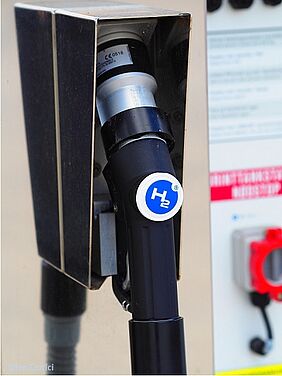In the constant search for cleaner transportation and industry fuels as well as means of power generation, scientists have long been concerned with finding more eco-friendly ways to produce hydrogen as this energy source usually does not release CO2 emissions. Its generation, however, is responsible for a lot of pollution, since most of the production processes rely on fossil fuels as feedstock. Also, it needs to be transported to the end user which creates additional CO2.
Now (2021), scientists at MIT have designed an alternative method of generating green hydrogen by reacting scrap aluminium with water. Aluminium is able to react with water at room temperature to form aluminium hydroxide and hydrogen. However, usually aluminium and water do not react due to a layer of aluminium oxide that coats the raw metal and shields it from direct contact with water. The aluminium-water reaction does not emit any greenhouse gases and hydrogen can also be produced en lieu in any location where water is available. Moreover, the aluminium becomes a mechanism for storing hydrogen.
Two problems have so far hindered the use of aluminium as a safe and economical source for hydrogen generation. The first problem is that the surface of the metal has to be cleaned and prepared to react with water. For this purpose, the oxide layer has to be adapted first and then the re-forming of the layer prevented as the reaction proceeds. The second problem is that pure aluminium is energy-intensive to produce, which means that any sustainable approach would need to use scrap aluminium from various sources. However, scrap aluminium typically occurs in an alloyed form and contains other elements which are usually added to change the properties or characteristics of the aluminium. Such elements might include magnesium, for example, which increases strength and corrosion-resistance or silicon which reduces the melting point. Therefore, in a first step the scientists tried to come up with an effective solution to penetrate the oxide layer forming on aluminium when exposed to the air. As the tiny grains of which aluminium is composed of do not match perfectly, a means to prevent the formation of the oxide layer on the interior grain surfaces seemed a viable option. The scientists pre-treated the aluminium by painting liquid metals on the surface and allowing them to permeate through the grain boundaries. To determine the effectiveness of this method, the researchers needed to make sure that the liquid metals would reach the internal grain surfaces, with and without alloying elements present. They had to find out how long it would take for the liquid metal to coat all of the grains in pure aluminium and its alloys. Based on hydrogen yield measurements and scanning electron microscope images, the MIT team concluded that the rate and extent of penetration vary with the alloy. The permeation rate was the same in silicon-doped aluminium samples as in pure aluminium samples but slower in magnesium-doped samples. The most interesting results were those gained from samples doped with both silicon and magnesium. The scientists discovered that when scrap aluminium contained both silicon and magnesium, those deposits could act as barriers. The experiments and images confirmed this hypothesis. Therefore, a thorough pre-treatment period would be needed for maximising the hydrogen yield from scraps of aluminium containing both silicon and magnesium. The researchers next analysed how the presence of alloying elements impacted hydrogen generation and also tested how different grain sizes affected production, as this might possibly increase the total surface area available for reactions to occur.
Scientists have long sought to find more sustainable ways for hydrogen production from aluminium. In 2019, aluminium powder prepared from waste aluminium cans using the magnetic grinding method which was then directly used in hydrolysis for hydrogen generation. The prepared powder was then analysed using by means of, for example, scanning electron microscope (SEM), X-ray diffraction (XRD), atomic absorption spectrophotometer (AAS) or density analysis. The results showed that grinding time, NaOH concentration, and reaction temperature decidedly impacted the hydrolysis rate and hydrogen yield. The reaction kinetics study showed that the hydrolysis of aluminium powder was kinetically controlled while hydrolysis of aluminium flakes was controlled diffusively. The generation of hydrogen from hydrolysis of waste aluminium with low-concentrated alkaline solution promised to be a feasible option to reducing pollution and instrument corrosion.
In 2021, scientists researched several composites made of aluminium, gallium, indium, tin and potassium chloride which were prepared by mechanical ball milling for hydrogen generation. Then, the effects of composite composition and preparation process on hydrogen generation were studied, as well as the optimal ball milling time for the composites to reach their maximum hydrogen yield. The microstructure characterization results showed that the intermetallic compound consisting of indium and tin was formed in these three composites, and the three composites exhibited different morphologies due to their different compositions and different milling times.
There are several advantages to using aluminium for hydrogen production: hydrogen at a density which was 10 times greater than that of compressed gas can be stored. Also no energy has to be applied for the liquid metals to work properly on the aluminium oxide layer. The metals do not chemically react with the aluminium and can be recovered at the end of the process. Moreover, the results showed that reducing grain size can increase the peak hydrogen flux from silicon-doped aluminium as much as 100 times, while with magnesium-containing aluminium, reducing the grain size led to an increase in peak hydrogen flux and a slightly faster decline in the rate of hydrogen output.
In this experiment the scientists have demonstrated two highly practical methods of modifying the hydrogen reaction rate: by adding certain elements to the aluminium and by manipulating the size of the interior aluminium grains. If combined, these two methods might eventually lead to a more sustainable method for hydrogen production from aluminium.
